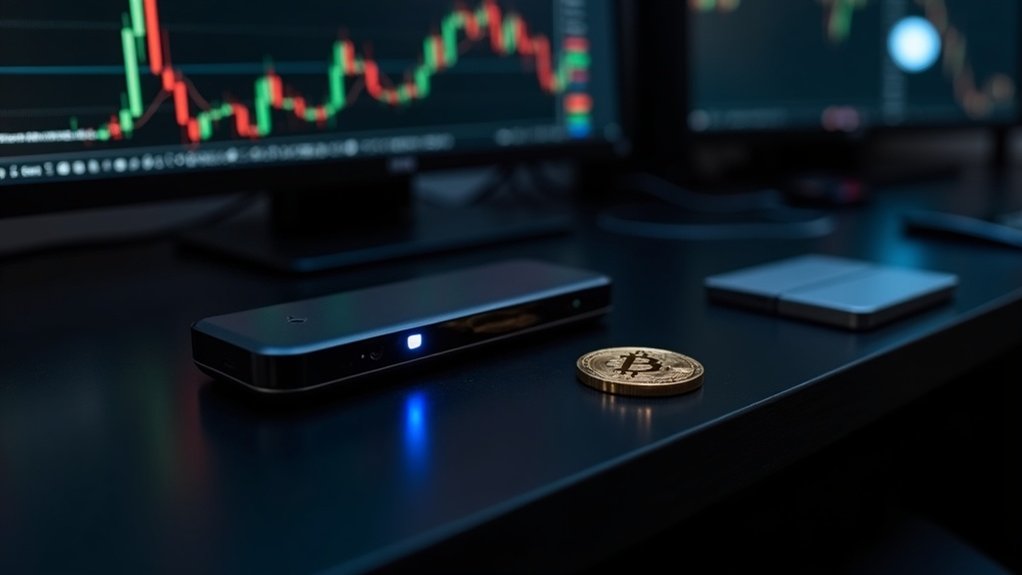A Bitcoin Spot ETF holds actual Bitcoin instead of futures contracts. Investors get exposure to BTC without managing digital wallets or private keys. Simple. These funds trade on regular stock exchanges, just like traditional ETFs. They’re secured by professional custodians using cold storage—way safer than some sketchy exchanges. Authorized Participants handle the creation and redemption process, keeping prices aligned with Bitcoin’s market value. Expect all the volatility of crypto with none of the technical headaches. The rest gets interesting.
The world of cryptocurrency just got more accessible.
Spot Bitcoin ETFs have finally arrived, offering investors a way to get Bitcoin exposure without the hassle of digital wallets or private keys.
These financial instruments do something pretty straightforward – they buy and hold actual Bitcoin, then let you purchase shares of that pool on regular stock exchanges.
No crypto exchanges needed. No worried texts to your tech-savvy nephew asking how to recover forgotten passwords.
These ETFs aren’t just convenient; they’re built with serious security in mind.
The Bitcoin is kept in cold storage with multi-signature protocols.
In plain English? It’s locked down tight.
The companies running these funds have professional custodians watching over your digital gold 24/7.
Much better than that sketchy exchange that might disappear overnight with everyone’s coins.
The mechanics are actually pretty interesting.
Large financial institutions called Authorized Participants handle the creation and redemption process.
They bring Bitcoin to the ETF and get shares in return, or vice versa.
This constant balancing act helps keep the ETF’s price in line with actual Bitcoin prices.
It’s market efficiency in action.
Unlike their futures-based cousins, spot ETFs hold the real deal.
Many providers now offer competitive expense ratios to attract investor interest.
No derivatives or contracts that expire. Just Bitcoin.
This means they track the actual market price more accurately.
Futures ETFs can drift from Bitcoin’s price due to speculation and market weirdness.
Investors get some clear benefits.
Trading is simple – just buy and sell like any stock.
You can even purchase fractional shares if you don’t have thousands to invest.
Plus, everything happens in a regulated environment.
Your traditional brokerage account works fine.
While these funds don’t pay dividends because Bitcoin generates no income, investors can still benefit from price appreciation if Bitcoin values increase over time.
Of course, it’s still Bitcoin.
The volatility will punch you in the face sometimes.
Prices swing wildly.
That’s just part of the game.
But for those wanting Bitcoin exposure without the technical headaches, spot ETFs offer a straightforward path.
Same rollercoaster ride, just with better safety bars.
For investors looking to dive deeper, there are extensive resources available to help with ETF understanding coming June 11, 2025.
Frequently Asked Questions
What Tax Advantages Do Bitcoin Spot ETFS Offer?
Bitcoin spot ETFs offer no special tax rates compared to other investments.
Their main advantage? They can be held in tax-advantaged retirement accounts like IRAs and 401(k)s—something you can’t do with direct Bitcoin ownership.
They also simplify tax reporting since they’re traded like stocks.
No more tracking multiple crypto transactions.
Still subject to capital gains tax though, and high earners won’t escape that 3.8% NIIT.
Convenient? Yes. Tax miracle? Hardly.
Can Bitcoin Spot ETFS Be Included in Retirement Accounts?
Yes, Bitcoin spot ETFs can absolutely be included in retirement accounts.
Recent regulatory shifts have made this possible.
Investors can now add these funds to their 401(k)s and IRAs—no direct crypto ownership required.
Tax advantages? Same as other retirement investments.
The Department of Labor has backed off its previous warnings about crypto.
It’s still volatile as hell, though.
These ETFs typically charge fees under 1%, which isn’t cheap but isn’t highway robbery either.
How Do Spot ETF Fees Compare to Crypto Exchanges?
Bitcoin spot ETF fees generally range from 0.15% to 1.5%, often cheaper than crypto exchanges for long-term investors.
Exchanges typically charge trading fees (0.1%-3%), withdrawal fees, and sometimes deposit fees.
Plus, exchanges come with extra headaches – security risks, wallet management, private keys.
ETFs? Just click “buy” through your regular brokerage.
No crypto wallets needed.
The tradeoff? ETFs have ongoing management fees while exchanges hit you per transaction.
Simple math, really.
What Happens to Spot ETFS During Bitcoin Forks?
During Bitcoin forks, spot ETFs face a moment of truth.
Fund managers must decide whether to claim forked tokens and distribute their value to shareholders.
Most don’t automatically include new coins unless their policies specifically allow it.
The ETF’s value follows Bitcoin’s price fluctuations during the fork period.
Investors get zero direct claim to forked assets—that’s the trade-off.
Regulatory guidance often influences how fund managers handle these digital offspring.
The custody arrangements? Complicated as hell.
Are Bitcoin Spot ETFS Insured Against Theft or Loss?
Bitcoin spot ETFs aren’t fully insured against theft or loss.
SIPC insurance covers the ETF shares themselves—not the actual Bitcoin.
Some custodians like Coinbase ($320 million) and Gemini ($100 million) have commercial crime insurance for digital asset theft, but this doesn’t directly protect investors.
If someone swipes the Bitcoin? You’re mostly out of luck.
FDIC and SIPC won’t touch the underlying crypto assets.
Welcome to the wild west of investing.









